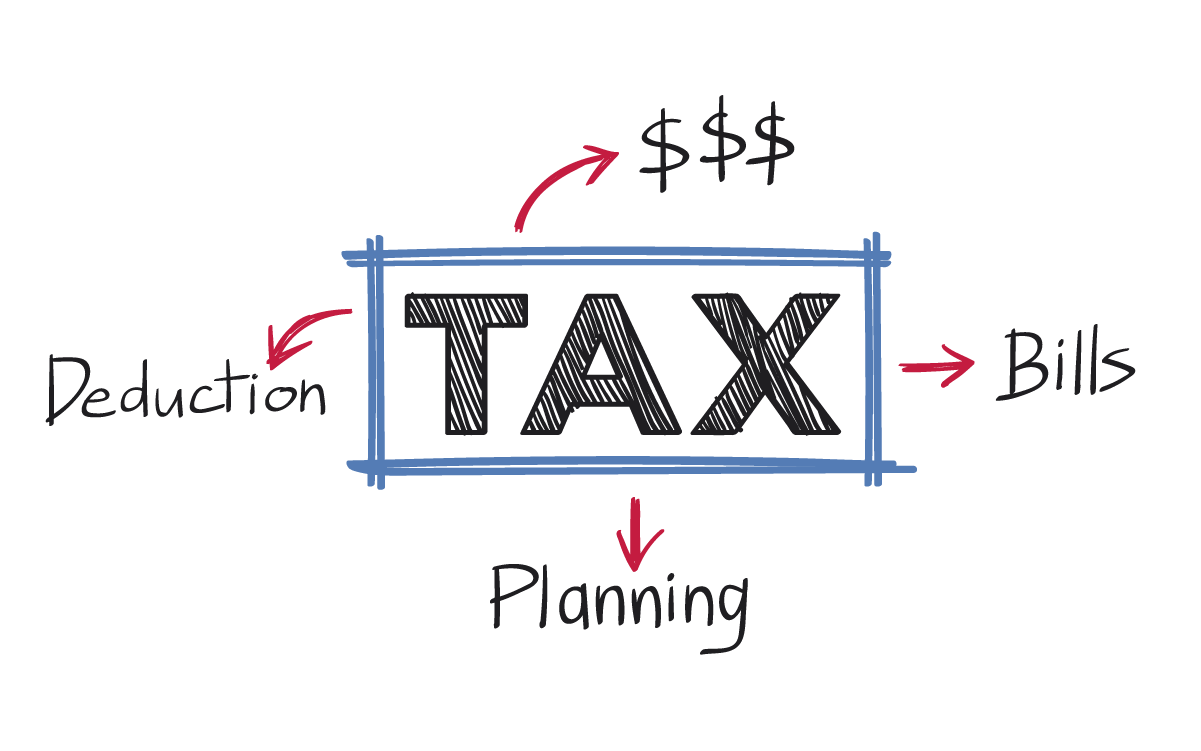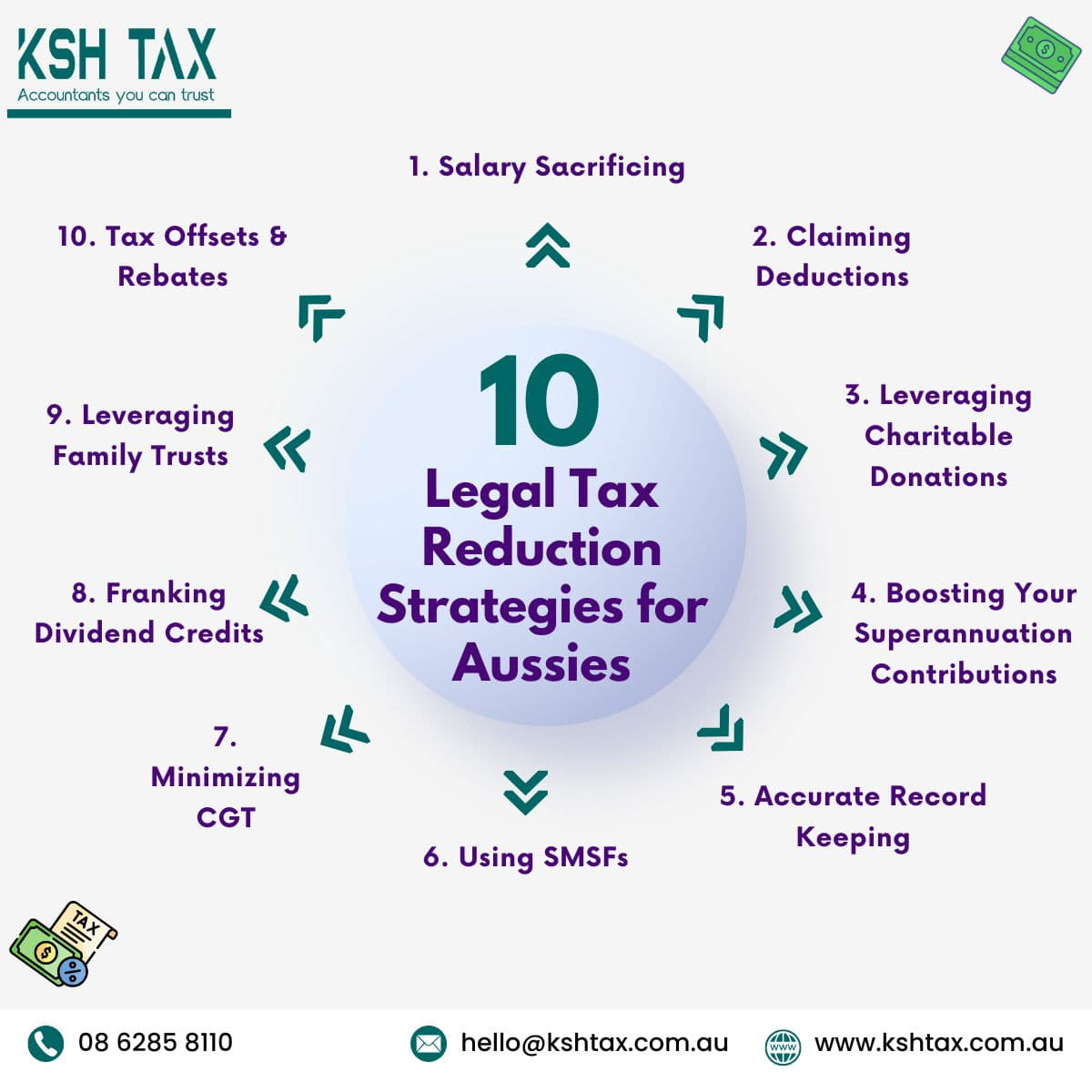
Are you looking to keep more of your hard-earned money while staying compliant with the Australian Taxation Office? Legal tax reduction strategies can make a significant difference in your financial well-being.
At KSH Tax Services, we understand the complexities of Australian tax law and help our clients navigate the best ways to minimize their tax obligations legally. A well-planned tax strategy can lead to:
This comprehensive guide explores proven methods to decrease your taxable income within the boundaries of Australian tax regulations.
From salary sacrificing to strategic deductions, we’ll uncover practical approaches that can help you achieve your financial goals while maintaining full compliance with tax laws.
Taxable income represents your total earnings minus eligible deductions during a financial year in Australia. This includes:
The Australian Taxation Office (ATO) calculates your tax liability using this formula:
Taxable Income = Assessable Income – Allowable Deductions
Your assessable income encompasses all sources of income, while allowable deductions cover expenses directly related to earning that income.
The ATO applies different tax rates to various income brackets, with higher earners paying progressively more tax.
Understanding these calculations helps you:
A clear grasp of these concepts forms the foundation for implementing effective tax reduction strategies that align with ATO regulations.
Salary sacrificing is one of the most effective tax minimization strategies available to Australian employees. This arrangement allows you to redirect a portion of your pre-tax salary towards specific benefits, reducing your taxable income.
Common salary sacrifice options include:
Let’s break down the practical benefits through an example:
Sarah earns $85,000 annually and decides to salary sacrifice $10,000 into her superannuation. This reduces her taxable income to $75,000, potentially saving her $3,450 in tax (based on 2023-24 tax rates).
The advantages extend beyond immediate tax savings:
To implement salary sacrificing, you’ll need to:
Smart investors understand the power of strategic timing when managing Capital Gains Tax.
The Australian tax system offers significant advantages for patient investors who hold their assets for longer periods.
The CGT discount represents a powerful tool in your tax minimization arsenal.
By carefully planning the timing of your asset sales and understanding the holding period requirements, you can significantly reduce your tax obligations on investment gains.

The Australian tax system offers numerous deduction opportunities for individuals. Here’s what you can claim:
Work-Related Deductions:
Investment-Related Deductions:
Personal Deductions:
To maximize these deductions, follow these guidelines:
The ATO scrutinizes claims closely, so ensure your deductions meet the three golden rules: they must be directly related to earning income, you must have records to prove it, and you can’t claim private expenses.
Making charitable donations allows you to support meaningful causes while enjoying tax benefits.
The Australian Taxation Office (ATO) permits tax deductions for donations of $2 or more to registered Deductible Gift Recipients (DGRs).
Eligible charitable organizations include:
To claim your charitable donations:
Pro tip: Many workplaces offer workplace giving programs where donations are deducted from your pre-tax salary, providing immediate tax benefits.
The ATO maintains a searchable database of DGR organizations on their website, making it easy to verify an organization’s eligibility status before making your donation.
Remember that gifts with material benefits, such as raffle tickets or charity dinner seats, are not tax-deductible – only genuine donations qualify for tax deductions.
Making additional superannuation contributions is a powerful strategy to reduce your taxable income while building a robust retirement nest egg.
The Australian tax system offers significant benefits for those who contribute beyond their employer’s mandatory 11% contribution.
A person earning $95,000 who salary sacrifices $10,000 to super could save approximately $3,250 in tax, assuming a marginal tax rate of 32.5%.
The contribution is taxed at 15% ($1,500) instead of their marginal rate ($3,250), resulting in immediate tax savings of $1,750.
These additional contributions create a dual benefit – reducing your current tax obligations while strengthening your retirement savings.
The compound effect of these contributions, combined with investment returns over time, can significantly boost your retirement wealth.
Proper record keeping serves as the backbone of successful tax deductions. The Australian Taxation Office (ATO) requires taxpayers to maintain detailed financial records for five years after lodging their tax returns.
These records act as concrete evidence to support your claims and maximize your eligible deductions.
Essential Records to Maintain:
Common Deductible Expenses:
Work-Related Expenses
Investment Property Costs
Additional Deductible Items
Creating a dedicated system for organizing these records streamlines your tax preparation process. Consider using digital tools like expense tracking apps or cloud storage solutions to store and categorize your receipts.
Taking clear photos of paper receipts helps preserve the information, as thermal paper receipts can fade over time.
Remember to record both the purpose and context of each expense. A simple note on receipts can help justify the expense’s connection to your income-earning activities when claiming deductions.
Family trusts are a strategic way to manage family wealth and optimize tax outcomes. These legal structures allow income to be distributed among family members in tax-effective ways.
Here’s how family trusts can benefit your tax position:
The trust can distribute different types of income to different beneficiaries:
A properly structured family trust allows for yearly adjustments in income distribution based on each family member’s tax position.
This flexibility creates opportunities to minimize tax while maintaining fairness in wealth distribution among family members.
Self-Managed Super Funds offer unique tax advantages while giving you direct control over your retirement investments.
These funds operate under a concessional tax rate of just 15% on earnings, creating significant opportunities for wealth accumulation.
Key Benefits of SMSFs:
SMSFs allow strategic timing of asset purchases and sales to optimize tax outcomes. You can implement sophisticated tax strategies, such as segregating assets between accumulation and pension phases to maximize tax efficiency.
The ability to pool family members’ superannuation into one fund creates opportunities for cost-effective investment strategies and shared administrative expenses.
This structure enables multi-generational wealth transfer with tax advantages not available through retail super funds.
Franking credits are a valuable tax benefit in the Australian taxation system. When Australian companies pay dividends from their after-tax profits, they can attach these credits to reflect the corporate tax already paid.
Here’s how franking credits work to your advantage:
For example:
If you receive a $700 fully franked dividend, it carries a $300 franking credit. Your gross dividend income becomes $1,000, but you’ve already effectively paid $300 in tax through the company.
This system prevents double taxation and can significantly reduce your personal tax burden. Investors often strategically select Australian companies with strong dividend franking policies to maximize their after-tax returns.
Franking credits prove particularly beneficial for:
The Australian tax system offers several valuable tax offsets and rebates that can significantly reduce your tax bill.
These credits directly decrease your tax payable, providing dollar-for-dollar reductions in your tax liability.
Key Tax Offsets Available:
Additional Tax Relief Options:
To claim these benefits, maintain detailed records of your eligibility criteria and relevant documentation. The ATO’s online services platform allows you to track available offsets based on your circumstances and income level.
Tax minimisation strategies require careful planning and expert knowledge of Australia’s complex tax laws. Working with a qualified tax accountant provides invaluable benefits:
Your financial situation is unique, and generic tax advice might not capture all available opportunities for tax minimisation. A qualified tax accountant can:
At KSH Tax, we specialise in helping individuals and businesses navigate Australia’s tax system. Our team of experienced professionals can develop tailored strategies to legally reduce your taxable income while maximising your wealth position.
Contact us today to discover how we can help you keep more of your hard-earned money through effective tax planning.